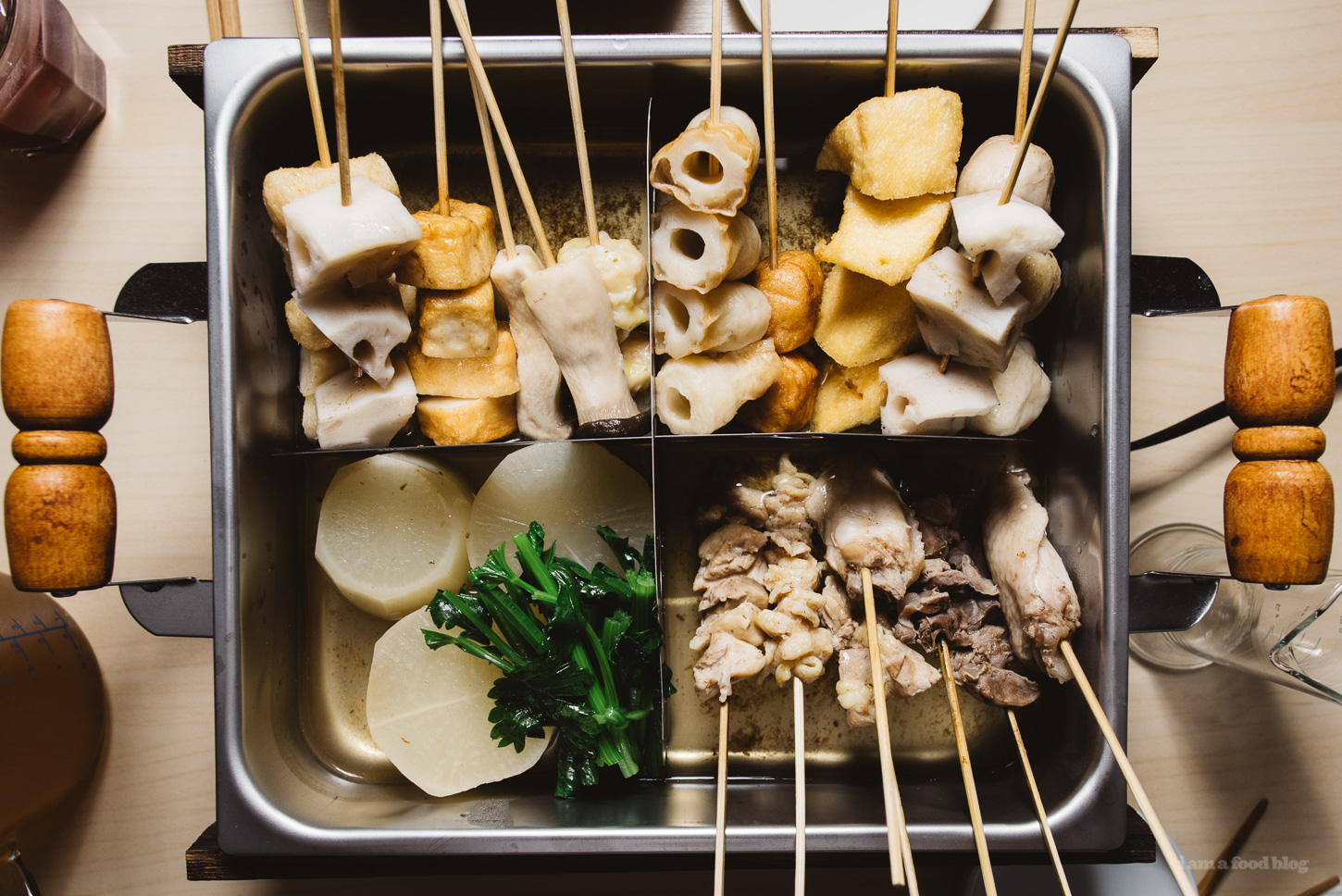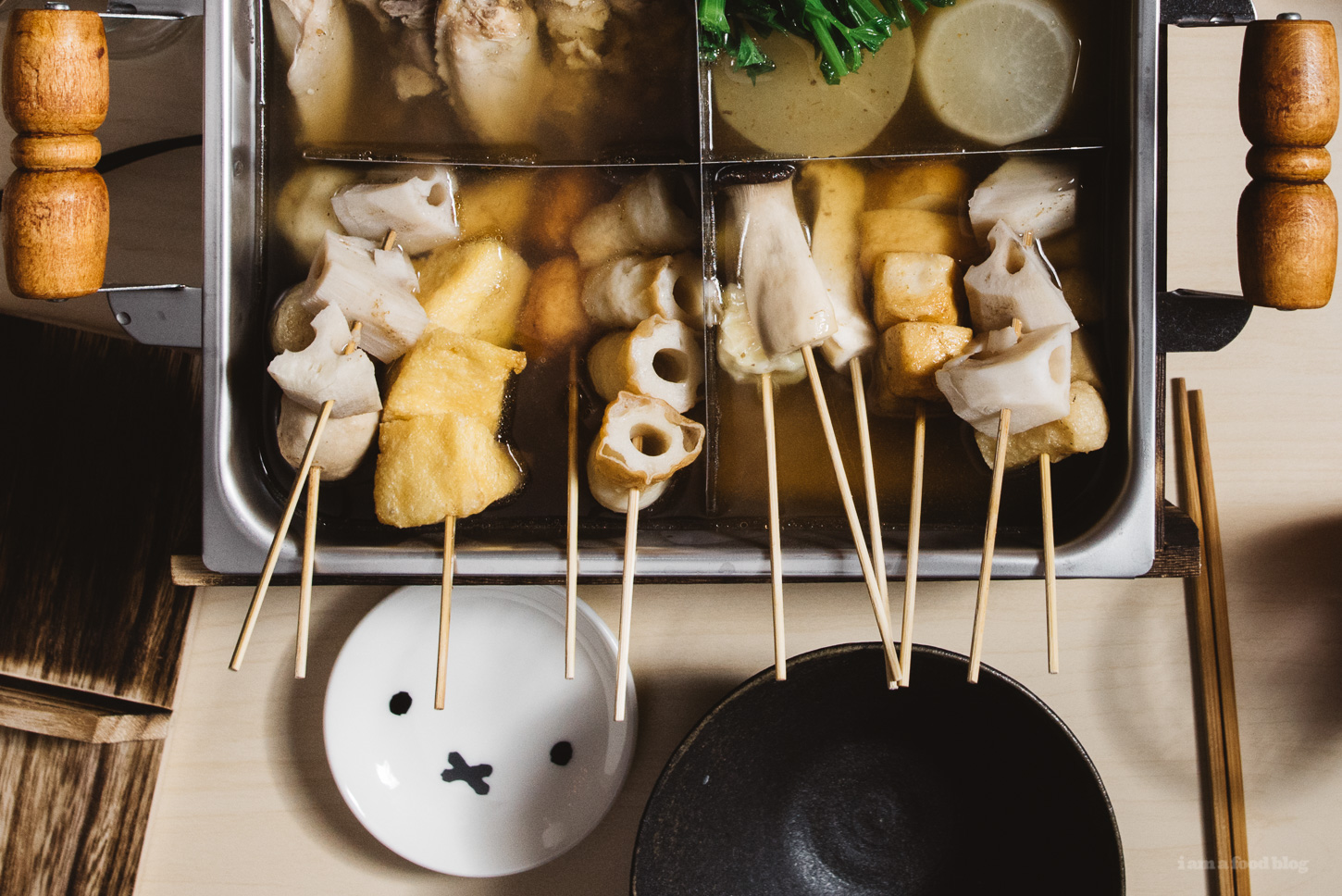When the weather turns cold, oden is the answer to what’s for dinner.
If you’ve ever been in Japan in the winter and hop into one of the many ubiquitous combini aka convenience stores like 7-11 or Lawson, chances are you’ll have seen oden: a steaming vat of soup featuring featuring things like fish cakes and tofu.
A huge pot of oden is a great way to gather around and enjoy winter. Mike and I love oden with a passion. We’ve eaten oden on the streets of Japan, at izakaya, in various kombini, and at dedicated oden restaurants. Dare I say we’re oden connoisseurs?


Fancy oden restaurants aside, I’m here to tell you that you’ve been sleeping on oden at home though. It’s just as amazing and so easy to make.
What is oden?
A classic warming winter snack or meal, oden is a one pot dish featuring fish cakes, tofu, and other hearty ingredients simmered in a flavorful soy-dashi broth. It’s a simmered dish that is continually kept warm.
The ingredients in oden are meant to be simmered for a long time so you don’t have to worry about anything being overcooked. In fact, the oden ingredients, are meant to soak up the flavor of the dashi.


How to make oden
Prep ingredients – peel the daikon and cut into 1 inch thick rounds. If desired, you can trim the edges of the daikon to round it out. Add the daikon rounds to a pot with cold water and bring to a boil and cook for 20 minutes. While the daikon is cooking, rinse off the konnyaku and lightly score the block with diagonal cuts, then cut into triangles. Add to a pot of boiling water for 3 minutes then drain and set aside. Prep the rest of the ingredients: cut the atsuage tofu into triangles and any of the larger pieces of satsuma age into smaller pieces. Cut the hanpen in quarters and the chikuwa in half on a diagonal.
Make the oden stock – In a large, heavy bottomed low pot, add dashi, soy sauce, sake, and mirin. Bring to a simmer.
Simmer – Add the prepared daikon, and konnyaku, then simmer over medium to medium low until the daikon starts to turn tender. Add the chikuwa, atsuage, and any other oden ingredients you’ve chosen. Simmer for another 10-15 minutes or until everything warms through and the daikon is tender.
Enjoy – Bring the pot to the table, where you can opt to keep it warm on a very low simmer on a burner. Pluck out your chosen pieces of oden as desired and enjoy!


Types of oden and oden ingredients
The beauty of oden is that it’s incredibly simple to make and prepare. Most of the ingredients that go in oden are things that you pick up at the store, like fish cakes, fish balls, and tofu. If you’re feeling like getting a bit fancy and offering up some other oden goodies, I’ll talk more about preparing those later in this post. Here is a list of the most comment types of oden ingredients.
Daikon
A classic! Daikon is a giant white radish that is cut into rounds and then simmered until soft and yielding, yet still a bit firm. Daikon oden is juicy and light, with plenty of the oden dashi flavor. Super tasty and a must.
Tamago/egg
Boiled eggs are extremely popular even though I don’t prefer them because they tend to be too over-cooked for me. If you want to do tamago, do a soft boiled egg, peel it, then very gently dip them in the oden stock to heat them up, making sure to not over cook.


Chikuwa
Fish cake that’s shaped into a tube then grilled. It’s a classic favorite, chewy, hearty, and good.
Hanpen
A delightfully soft and squishy fluffy steamed fish cake. When it’s simmered it becomes super big and fluffy, full of dashi.


Satsuma-age
A catch all for all the deep-fried fish cakes. They come in flat rounds, flat ovals, balls, and plenty of other shapes. You can tell they’re satsuma age from their deep orange golden color.
Konnyaku
Chewy and jelly-like, konnyaku is a love it or hate it ingredient. I love it and if you’ve ever had house made konnyaku at a specialty oden shop, you’ll forever be chasing that flavor and texture.
Shirataki
They look like a bundle of white noodles, but really they’re a bundle of konnyaku that’s shaped like noodles. Chewy, filling, and delicious.
Atsuage
Deep-fried tofu. A large, thick slab of tofu that’s deep fried and holds up perfectly in oden.


Kinchaku
A deep-fried tofu pocket with a secret mochi surprise inside! Careful, because they’re hot and the mochi is molten and melty. I love kinchaku.


Ganmo
I love ganmo! It’s a piece of tofu made with vegetables inside and then deep-fried. They’re usually round and have little bits of burdock or wood ear mushrooms studded through the tofu. They soak up the dashi and are incredibly delicious.
Other ingredients
These are some other things you can pop into your oden, but you’ll have to make them because they don’t come ready-made at the store. Usually you’ll find these kind of oden offerings at oden specialty restaurants or at izakaya.
Tsukune – soft and juicy chicken meatballs on a stick.
tebasaki – chicken wings, usually on a stick, simmered until tender and juicy.
Gyusuji – served on a stick, beef tendon is simmers until soft and chewy.
Rorukyabetsu – literally rolled cabbage, this is similar to a cabbage roll where a cabbage leaf is rolled around a gyoza-like filling.


Where to buy oden ingredients
The best place to buy oden ingredients is at a local Asian grocery store. If you have a Japanese grocery store in town, that’s where you’re want to go. You’ll find all of the fish cakes in the frozen section, usually all together. Sometimes they’ll even have oden packs where they have a variety of fish cakes all conveniently together. You’ll find daikon in the vegetable department, and konnyaku and tofu next to each other in one of the fridge cases. For the dashi, you’ll find that in one of the aisles, usually near the soup stock section.


What kind of soup should I use
The classic soup base for oden is awase dashi flavored with sake, mirin, and soy. Awase dashi is combination dashi, made from both dried kelp (kombu) and katsuobushi (dried skipjack tuna).


How to make dashi
There are three ways most people make dashi.
1. kombu and katsuobushi: simmer kombu in water for about 10 minutes, remove the kombu, then steep the katsuobushi before straining.
2. dashi granules: simply add dashi granules to water.
3. dashi packs: this is my favorite way of making dashi – bring a pot of water to a boil, lower it to a simmer and add the dashi pack. Dashi packs contain both kombu and katsuobushi in a handy packet that you can fish out so you don’t have to strain your dashi. Dashi packs are readily available online: this is our favorite brand, Kayanoya, straight from Japan.
Where is oden from?
Oden is a classic Japanese stew, a type of nabemono, or one pot dish. Nabe means cooking pot and mono means “things” so nabemono is things in pot. In oden’s case, the things in a pot are a variety of fish cakes, proteins, and vegetables.
If you’re more familiar with Korean culture, maybe you know about odeng, which is essentially a Korean take. The Korean version usually features long flat fish cakes on skewers and is sometimes seared with a spicy soup.


How to serve
Typically, the way oden is served in Japan is piece by piece. You order your favorite pieces of oden from the chef, and they scoop it out and plate it individually or with a couple of pieces on a plate or in a small bowl. They place it in front of you and you enjoy. Repeat as needed trying new pieces or getting more of your favorites until you’re full.
At home, what we tend to do is have a pot of oden in the middle of the table, either gently simmering on a burner or keeping warm in our oden pot. We use tongs to fish out the pieces we like, eat them, and repeat. It’s a super simple serve yourself kind of meal. We’ll have side plates and chopsticks, and tiny dishes for condiments. Sometimes if we’re extra hungry, we’ll have a bowl of rice along side or maybe some udon. Usually though, we just enjoy the pieces of oden. If we’re feeling like we really want to go all out, I’ll grill some yaki onigiri for us to enjoy.
What kind of sauce for oden
Typically they don’t serve a dipping sauce because the simmered pieces are really flavorful. That being said, when you go to a restaurant they often have sweet soy sauce, karashi (Japanese mustard), or yuzu kosho (a spicy paste made with yuzu and chili), and a miso sauce for dipping if you prefer.
That’s it! I hope you give it a try. It really is the most comforting winter meal and I can think of nothing I enjoy more when it’s snowing out side and we’re all cozy inside with a big pot of oden in the middle of the table.
Happy oden-ing!
xoxo steph


Oden recipe
Ingredients
Soup
- 8 cup dashi
- 1/4 cup light soy sauce
- 2 tbsp sake
- 2 tbsp mirin
Items
- 1/4 medium daikon radish
- 1 block konnyaku
- 1 large piece atsuage/deep fried tofu
- 3 pieces chikuwa
- 1 piece hanpen
- 1 package satsuma age assorted
- 4 kinchaku
- 4 soft boiled eggs
Instructions
-
In a heavy bottomed pot, like cast iron, bring the dashi, soy sauce, sake, and mirin up to a gentle simmer. Turn the heat off or down to low while you prepare the oden ingredients.


-
Peel the daikon and cut it into 1 inch rounds. If desired, trim so the daikon has no sharp edges. Add the daikon to a pot and top with cold water. Bring the daikon to a boil over medium heat and cook for 20 minutes. When done, remove from the water and set aside.


-
While the daikon is cooking, prep the rest of the ingredients: cut the atsuage tofu into triangles and any of the larger pieces of satsuma age into smaller pieces. Cut the hanpen in quarters and the chikuwa in half on a diagonal. If any of the pieces of satsuma age are extra large, cut them in half or in quarters.
If using konnyaku: Rinse off the block and lightly score the surface on a diagonal then score on the opposite diagonal, creating a diamond crisscross pattern. Cut the block of konnyaku into 3 even pieces then cut the 3 pieces in half into triangles. Bring a small pot of water to a boil and when boiling, add the konnyaku pieces and boil for 3 minutes. Drain, rinse, and set aside the konnyaku pieces.


-
When the daikon cooking time is up, add the daikon and konnyaku to the oden broth and bring to a simmer over medium low to low. Cook the daikon and konnyaku for 20 minutes, then add the remaining ingredients, aside from the boiled eggs. Simmer all of the ingredients for 10-15 minutes or until all of the ingredients soak up some of the dashi and are throughly hot.


-
Bring the pot to the table and enjoy, picking out pieces of oden to enjoy as desired. For the eggs, add them as desired, until just heated through, being sure to not overcook.


Notes
Estimated Nutrition
Calories from Fat 86










